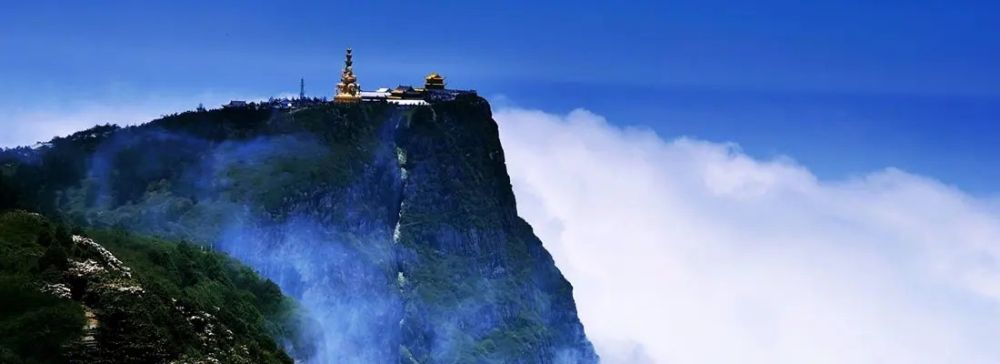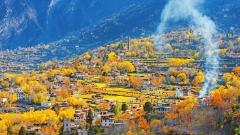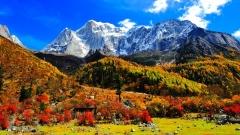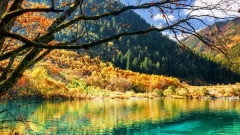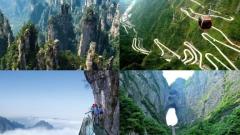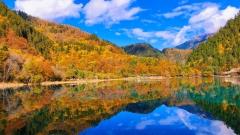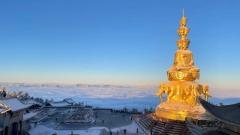Mount Emei (also called Emeishan or Emei Mountain) rises majestically from the southwest edge of the Chengdu Plain in Leshan City, Sichuan Province. With an undulating silhouette that resembles the delicate arch of a maiden’s eyebrow, this emerald-clad peak stands as the highest among China’s renowned sightseeing mountains. Stretching 23 km in length and covering some 154 km², Mount Emei boasts a timeless blend of verdant forests, cascading waterfalls, mist-shrouded crags, and rich Buddhist heritage. In 1996, UNESCO recognized its outstanding universal value by inscribing it on the World Natural and Cultural Heritage List. Whether you’re seeking panoramic vistas, cultural discovery, or an immersive hiking adventure, Mount Emei delivers an unforgettable journey.
Mount Emei Four Scenic Regions: From Baoguo to Golden Summit
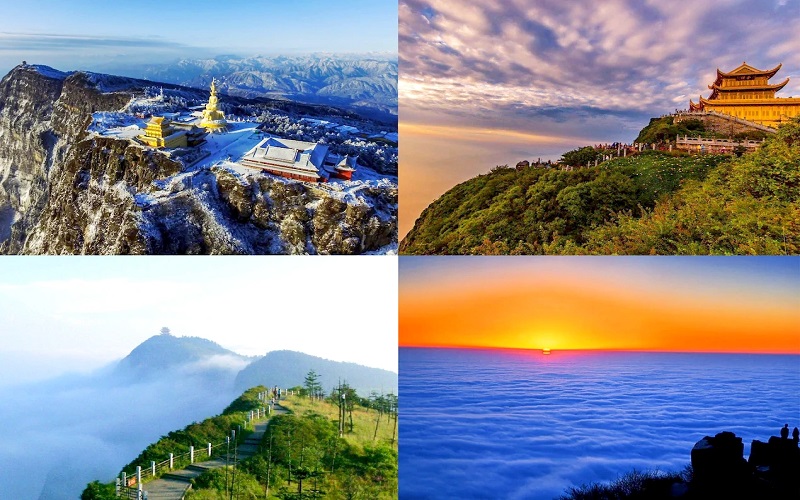
Mount Emei Four Scenic Regions
Mount Emei is divided into four primary scenic areas, each offering distinct landscapes and cultural highlights. A complete exploration weaves together serene temples, tranquil pavilions, and awe-inspiring high-altitude panoramas.
- Baoguo Temple Area
Nestled at the mountain’s base, Baoguo Temple serves as the main gateway for visitors. This sprawling complex features traditional Sichuanese architecture, intricate wooden carvings, and vibrant prayer halls. Surrounding the temple, you’ll find the Emeishan Museum, which introduces the mountain’s geology, biodiversity, and early human activities. From here, guided eco-buses and hiking trails fan out to the mid-mountain attractions. - Wannian Temple Area
Ascend via cable car or hike to reach Wannian Temple, one of the oldest and most revered sanctuaries on Mount Emei. Founded nearly 1,900 years ago, this cliffside monastery boasts soaring wooden beams, painted rafters, and a serene courtyard overlooking the valley. Monks chant within its halls, preserving centuries of Buddhist music and ritual. The Temple’s perch also offers glimpses of the “Monk’s Waist” stone path and the verdant Tiger Falls nearby. - Qingyin Pavilion Area
Further uphill lies the wooded haven of Qingyin Pavilion, named for the echoing sound of wind through pine needles. Here, narrow paths wind past ancient cedars and hemlocks, opening onto hidden springs, mossy grottoes, and the famous “Listen to the Spring beside Tiger Brook.” Many poets and painters have drawn inspiration from this tranquil respite, where sunlight filters through dense foliage, painting the forest floor in dappled gold. - Golden Summit (Jinding)
At 3,079.3 m above sea level, the Golden Summit is Mount Emei’s crowning glory. Its name comes from the golden hue that bathes the summit pavilion at dawn. From this lofty vantage, you can behold the westward snow-dusted peaks of the Hengduan Mountains and the endless Chengdu Plain to the east. Four natural spectacles make this site legendary:- Sea of Clouds: A shifting ocean of mist that surges below you on cool mornings.
- Sunrise: The fiery burst of dawn illuminating mountain ridges in amber light.
- Buddha’s Rays: Radiant shafts of sunlight penetrating the mist, likened to lotus petals.
- Sacred Lamps: Sporadic flickers of red and gold light at dusk, steeped in local legend.
The scenery of Mount Emei in all seasons
Emei’s microclimates and dramatic elevation changes produce a kaleidoscope of scenery throughout the year:
- Spring (March – May): Rhododendrons, azaleas, and camellias burst into bloom along the trails. Waterfalls swell with melted snow, feeding torrents that cascade down mossy cliffs.
- Summer (June – August): Verdant foliage forms a dense canopy, while frequent mists lend an air of mystery. The cooler temperatures at higher elevations offer respite from Chengdu’s heat.
- Autumn (September – November): Golden ginkgo and maple leaves paint the slopes in fiery hues. Crisp air enhances visibility of both sunrise glories and far-reaching panoramas.
- Winter (December – February): Snow carpets the summit and upper ridges, transforming the trees into frosted sculptures. Limited crowds make for a serene, almost otherworldly atmosphere.
Qing Dynasty poet Tan Zhongyue famously cataloged ten classic vistas of Mount Emei; modern visitors continue to discover new viewpoints like the “Plank Road above Longjiang River” or the “Flying Waterfall over Dragon Gate.” Bring a spirit of curiosity—you might just name your own favorite scene.
Tracing Emeishan’s Buddhist Heritage
Long before formal temples dotted its slopes, Mount Emei’s rugged terrain held spiritual significance for Daoist and indigenous mountain worship. Archaeological evidence implies human habitation here some 5,000 years ago. Legend has it that Emperor Xuanyuan (the Yellow Emperor) visited twice to study Daoist philosophy. However, it was during the Eastern Han Dynasty (circa 3rd century CE) that Buddhist monks erected the first monastery, cementing Emei’s status as the cradle of Buddhism in the Yangtze Valley.
Over centuries, more than 20 temples, pavilions, and grottoes sprang up along pilgrimage routes. Intricately carved stone reliefs, ancient cave shrines, and operatic-style Buddhist music echoing through temple halls reveal a syncretic culture that blends Mahayana Buddhism with local folk traditions. Monastic communities still reside in several temples, and you can witness daily chanting ceremonies, meditate in quiet halls, or explore painting galleries depicting Jataka tales (stories of the Buddha’s past lives).
Mount Emei Practical Information: Fees, Hours, and Best Seasons
To plan your visit effectively, keep these key details in mind:
| Item | High Season (Jan 16–Dec 14) | Low Season (Dec 15–Jan 15) |
|---|---|---|
| Mount Emei Entry | CNY 160 | CNY 110 |
| Baoguo Temple | CNY 8 | CNY 8 |
| Fuhu Temple | CNY 10 | CNY 10 |
| Wannian Temple | CNY 10 | CNY 10 |
Opening Hours:
- High Season: 06:00 – 18:30
- Low Season: 07:00 – 17:50
Best Time to Visit:
Spring (March–May) and Autumn (September–November) offer the most comfortable weather, peak foliage displays, and optimal visibility for summit sunrises and sea-of-clouds spectacles.
Getting to Mount Emei: From Chengdu and Leshan
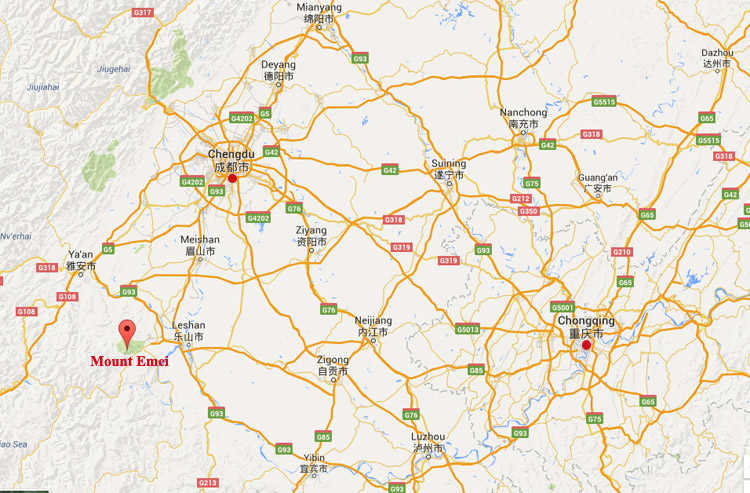
Map to Mount Emei
From Chengdu (≈ 150 km):
- High-Speed Train: Chengdu East/South Station → Emeishan Station; then transfer to tourist bus No. 5A, No. 8, or local shuttle to Baoguo Temple.
- Long-Distance Bus: Xinnanmen Bus Station → Emeishan Tourism Bus Center; walk to Baoguo Temple entrance. Buses depart 07:20–19:35 (fills to capacity), ~2.5–3 hr journey, CNY 51.
From Leshan (≈ 50 km):
- Train: Leshan Railway Station → Emeishan Station; then bus to Baoguo Temple.
- Bus: Xiaoba Bus Station → Baoguo Temple Bus Station; departs 07:30–18:00, ~1 hr, CNY 11.
- Chartered Mini-Bus: From Leshan downtown or Giant Buddha scenic area, CNY 20–30, ~1 hr. Confirm drop-off at the Mount Emei scenic zone before boarding.
Navigating the Scenic Area: Buses, Cable Cars, and Trails
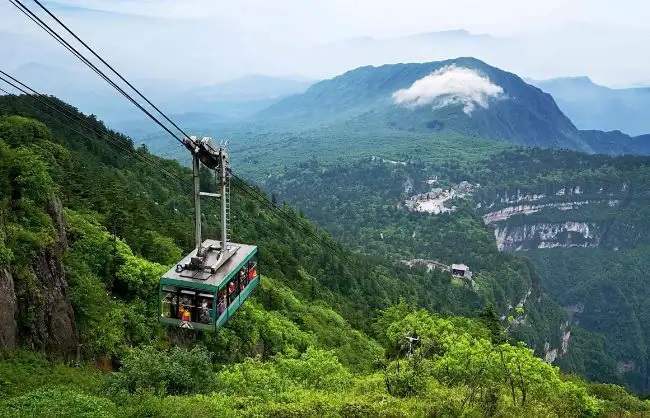
Cable Cars
Sightseeing Buses: Convenient for mid-mountain transfers, these eco-friendly buses link key stations:
- Baoguo Temple Center: Baoguo Temple, Emeishan Museum
- Wuxiangang Station: Qingyin Pavilion, Yixiantian, Monkey Viewing Zone
- Wannian Temple Station: Temple precincts, White Dragon Cave
- Leidongping Station: Jieyin Palace, Golden Summit access
Bus Schedule:
- Nov–Apr 25: 07:00–16:00 every 30 min; hourly after 12:00
- Apr 26–Oct 30: 07:00–17:00 every 30 min
- Chinese Public Holidays: 05:00–17:00 every 10 min; 30 min after 12:00
Cable Cars: Save time and energy ascending to higher altitudes.
- Jinding Line (to Golden Summit):
- High Season: CNY 65 (up) / CNY 55 (down); 05:30–18:00
- Low Season: CNY 30 (up) / CNY 20 (down); 07:30–18:00
- Wannian Line (to Wannian Temple):
- High Season: CNY 65 (up) / CNY 45 (down); 06:40–18:00
- Low Season: CNY 30 (up) / CNY 20 (down); 07:30–18:00
Hiking Trails:
- Leidongping → Golden Summit: Shorter trail for sunrise chasers.
- Wannian Temple → Golden Summit: Moderate hike with rich temple stops.
- Qingyin Pavilion → Golden Summit: Extended trek through deep forest and hidden springs.
Crafting Your Mount Emei Itinerary
Depending on your interests and fitness level, your Mount Emei adventure can span from a full-day excursion to a multi-day pilgrimage:
One-Day Express Tour:
-
- Early departure from Chengdu, arrive Baoguo Temple by 08:00.
- Cable car to Leidongping; hike to Golden Summit for sunrise (if timed).
- Descend by bus to Wannian Temple, enjoy lunch in temple courtyard.
- Return via bus or cable car to Baoguo Temple by late afternoon, then back to Chengdu.
Two-Day Cultural & Nature Retreat:
-
- Day 1: Baoguo Temple → Wannian Temple (explore temple, meditate) → Overnight at mid-mountain lodge.
- Day 2: Dawn hike or cable car to Golden Summit → Qingyin Pavilion on descent → Emeishan Museum → Return to Leshan or Chengdu.
Three-Day Deep Immersion:
-
- Day 1: Leshan Giant Buddha visit en route; check-in at foot-of-mountain guesthouse.
- Day 2: Hike from Wannian Temple to Golden Summit; camp or stay at summit hotel (advance booking required).
- Day 3: Explore Qingyin Pavilion and hidden grottoes; leisure return by eco-bus and train or bus.
Accommodation Options:
- Foot-of-Mountain Inns: Simple, family-run guesthouses near Baoguo Temple.
- Mid-Mountain Lodges: Rustic stays at Wannian or Leidongping—book early for summit sunrise access.
- Summit Hotels: Limited rooms with direct sunrise views; ideal for photographers and contemplative travelers.
Wildlife Encounters and Hot Springs Relaxation in Mount Emei
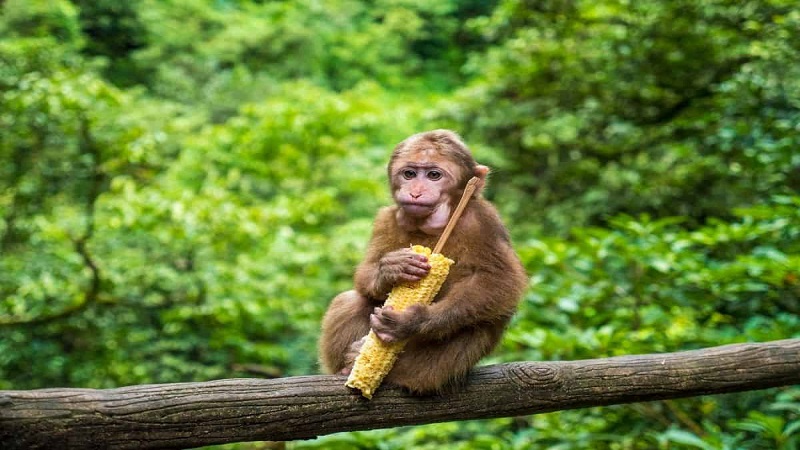
Wildlife Encounters in Mount Emei
Mount Emei’s wildlife is as diverse as its scenery. Troops of macaque monkeys frequent eco-bus stops and trail edges—observe respectfully and secure your belongings. Rare species like clouded leopards, giant salamanders, and over 3,700 plant varieties flourish in this biodiversity hotspot.
After a day of trekking, soothe your muscles in nearby hot springs at the mountain’s base. These geothermal pools, rich in minerals, offer therapeutic benefits and an authentic Sichuan leisure experience. Pair your soak with local delicacies—spicy hotpot or tender bamboo-shoot stir-fries—for a well-rounded retreat.
Capturing the Essence: Photography and Cultural Etiquette
- Sunrise & Sea of Clouds: Use a sturdy tripod and wide-angle lens for dramatic compositions. Weather apps can help predict mist conditions.
- Temple Interiors: Modest attire is appreciated; avoid flash photography during rituals. Respect signs indicating restricted areas.
- Monkey Safety: Do not feed or provoke wildlife. Keep cameras and snacks secured to prevent accidental theft or injury.
- Local Customs: Monks may silently move through temple grounds—observe quietly and defer to their service spaces. A slight bow when entering a prayer hall signifies respect.
Embarking on Your Mount Emei Adventure with China Dragon Travel
Navigating Mount Emei’s sprawling landscapes, sacred shrines, and seasonal wonders can be an exhilarating yet complex endeavor. At China Dragon Travel, we specialize in customized Sichuan journeys that seamlessly blend cultural immersion, logistical ease, and authentic encounters. Whether you dream of witnessing a golden sunrise atop Jinding, tracing ancient pilgrimage routes through mist-laden forests, or discovering hidden grottos off the beaten path, our expert consultants will tailor every detail to your preferences. From train and bus transfers to temple reservations, eco-bus and cable car schedules, to curated homestays and summit lodges—we handle it all, so you can focus on creating memories that last a lifetime. Contact China Dragon Travel today, and let us lead you to the heart of Mount Emei’s timeless magic.



